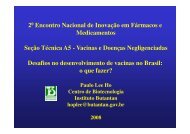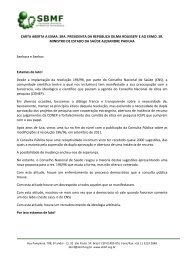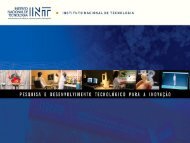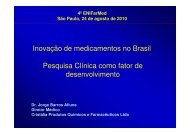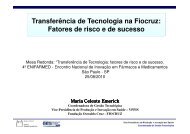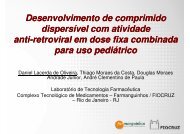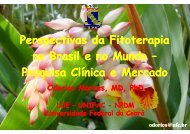Gilberto Denucci - IPD-Farma
Gilberto Denucci - IPD-Farma
Gilberto Denucci - IPD-Farma
You also want an ePaper? Increase the reach of your titles
YUMPU automatically turns print PDFs into web optimized ePapers that Google loves.
Dúvidas<br />
denucci@gdenucci.com<br />
Arquivo<br />
Ensaios Fase 0 e Fase 1<br />
Site<br />
www.gdenucci.com
Desenvolvimento de um Medicamento<br />
Testes Pré-clínicos<br />
Testes Clínicos (Humanas)<br />
Dose (Conc)<br />
Resposta clínica<br />
População PK/PD<br />
Grandes ensaios clínicos<br />
In vitro PK/PD<br />
Animal PK/PD<br />
Aumento escalonado<br />
da dose<br />
Tolerância<br />
Eficácia<br />
Seleção da Dose<br />
Vigilância<br />
pós-mercado<br />
PK/PD em população<br />
especiais<br />
Testes em animais<br />
Fase I<br />
Vols sadios<br />
Fase II<br />
Poucos pctes<br />
Fase III<br />
Muitos pctes<br />
Fase IV<br />
População
Livro de Daniel (capítulo I)<br />
8<br />
Ora Daniel tomou a firme decisão de não se contaminar com as iguarias do<br />
rei e o vinho que era sua bebida. Fez um pedido ao preposto do pessoal para<br />
não ter de se contaminar, 9<br />
e Deus concedeu a Daniel graça e favor diante do<br />
preposto do pessoal.<br />
10<br />
O preposto do pessoal disse a Daniel: “Temo que o<br />
rei, meu senhor, que fixou vossa alimentação e vossa bebida, vos veja de<br />
rostos mais abatidos que os dos jovens de vossa idade, e que vós me torneis<br />
culpado do preço de minha cabeça diante do rei”. 11 Daniel disse ao guarda k<br />
que o preposto do pessoal encarregara de Daniel, Hananiá, Mishael e<br />
Azariá: 12 “Põe teus servos à prova durante dez dias. Que nos sejam dados<br />
legumes para comer e água para beber. 13 Depois olharás para nosso rosto e o<br />
rosto desses moços que comem das iguarias do rei; e age para com teus<br />
servos segundo o que vires!” 14 Ele lhes deu ouvido e um prazo de dez dias,<br />
viu-se que eles tinham melhor aparência do que todos os jovens que comiam<br />
das iguarias do rei.
<strong>Farma</strong>cologia Clínica<br />
• Avaliação de novas entidades químicas em<br />
humanos (primeira administração em humanos)<br />
• Estudos de biodisponibilidade/bioequivalência<br />
• Estudos de toxicologia clínica (fitoterápicos)<br />
• Desenvolvimento de estudos farmacodinâmicos<br />
em humanos<br />
• Desenho e condução de estudos fase II, fase III e<br />
fase IV juntamente com outras especialidades
<strong>Farma</strong>cologia Clínica<br />
• Apesar de ser considerada Pedra de Toque<br />
para desenvolvimento da indústria<br />
farmacêutica, a <strong>Farma</strong>cologia Clínica não é<br />
considerada especialidade médica em nosso<br />
meio
Testes Pré-clínicos para Fase I<br />
(dose única)<br />
• Testes in vitro – mutagenicidade (Ames)<br />
• Testes in vivo – duas espécies animais<br />
(uma não roedora) por duas semanas
Testes Pré-clínicos para Fase I<br />
(dose múltipla)<br />
• Testes in vitro – mutagenicidade (Ames)<br />
• Testes in vivo – duas espécies animais<br />
(uma não roedora) por quatro semanas
Testes Clínicos<br />
• Fase 0 – voluntários sadios (microdosagem) – não é<br />
regulatória<br />
• Fase I – voluntários sadios<br />
• Fase II – pacientes para prova conceitual<br />
• Fase III – grande número de pacientes – estudos<br />
multicêntricos<br />
• Fase IV – vigilância pós-mercado – pesquisa sobre novas<br />
indicações
Detecção de reações adversas<br />
Incidência esperada de uma<br />
reação adversa<br />
Número de pacientes necessários<br />
para detecção do evento<br />
1 evento 2 eventos 3 eventos<br />
1 em 100 300 480 650<br />
1 em 200 600 960 1.300<br />
1 em 1.000 3.000 4.800 6.500<br />
1 em 2.000 6.000 9.600 13.000<br />
1 em 10.000 30.000 48.000 65.000
Phase I Study<br />
• Safety<br />
• Tolerability<br />
• Pharmacokinetic properties<br />
• Pharmacodynamic effects
Phase I – Safety<br />
• Does the drug produce any<br />
potentially dangerous effects, e.g. on<br />
cardiovascular, respiratory, hepatic or<br />
renal function?
Phase I – Tolerability<br />
• Does the drug produce any<br />
unpleasant symptoms, e.g., headache,<br />
nausea, drowsiness?
Phase I – Pharmacokinetic properties<br />
• Is the drug well absorbed? What is the<br />
time course of the plasma concentration?<br />
Is there<br />
evidence of accumulation or<br />
non-linear kinetics?
Phase I – Pharmacodynamic effects<br />
• Does a novel analgesic compound block<br />
experimentally induced pain in humans?<br />
How does the effect vary with dose?
Phase I Studies<br />
• Generally performed in a small<br />
number of healthy paid volunteers<br />
(normally 20-80).
Desenvolvimento de um Medicamento<br />
Testes Pré-clínicos<br />
Testes Clínicos (Humanas)<br />
Dose (Conc)<br />
Resposta clínica<br />
População PK/PD<br />
Grandes ensaios clínicos<br />
In vitro PK/PD<br />
Animal PK/PD<br />
Aumento escalonado<br />
da dose<br />
Tolerância<br />
Eficácia<br />
Seleção da Dose<br />
Vigilância<br />
pós-mercado<br />
PK/PD em população<br />
especiais<br />
Testes em animais<br />
Fase I<br />
Vols sadios<br />
Fase II<br />
Poucos pctes<br />
Fase III<br />
Muitos pctes<br />
Fase IV<br />
População
What are the advantages of conducting a<br />
Phase 0 trial?<br />
Due to their design, Phase 0 trials can be conducted in less time with<br />
fewer patients than Phase I trials. By conducting a Phase 0 trial on a<br />
particular drug, the process for Phase I and II trials on that drug is<br />
accelerated. Additionally, because Phase 0 trials study how the body<br />
reacts to the drug and how the drug acts in the body, if a drug is found<br />
to react poorly or to have serious side effects, the testing for that drug<br />
can be stopped sooner, without the additional expense of further trials.<br />
As a limited number of low doses of drug are given in a Phase 0 trial,<br />
the risk to the participant is minimal, if any.
Additional benefits of Phase 0 trials<br />
• Because the toxicology testing required prior to initiating Phase 0 clinical trials<br />
is reduced due to the low doses of drug used, these trials can be initiated<br />
substantially sooner than the standard Phase 1 study.<br />
• Phase 0 trials could facilitate rational drug selection, identify therapeutic<br />
failures early, and compress timelines for anticancer drug development.<br />
• Phase 0 trials provide initial rationale and guiding principles for further drug<br />
development based on studies in humans (rather than xenografts, where tissues<br />
of one species are transplanted to another species).<br />
• Phase 0 trials that focus on extensively characterizing how a drug works and<br />
whether it hits its intended target (including molecular imaging studies) in a<br />
limited number of patients could yield results that would optimally inform and<br />
expedite the subsequent development of molecularly-targeted agents.
Additional benefits of Phase 0<br />
• The results of Phase 0 trials can improve the efficiency and chance of<br />
success of subsequent trials.<br />
• Phase 0 trials could help to evaluate the effects of an agent at the<br />
molecular level, select the lead agent from a group of compounds, and<br />
assist in optimizing the selection of the starting dose for subsequent<br />
studies. In addition, these studies can aid in developing reasonable dose<br />
escalation schedules, whereby doses of a drug are slowly increased over<br />
time in order to find the highest dose with an acceptable level of adverse<br />
side effects in the patient.
Phase 0 for which drugs?<br />
Phase 0 trials are useful for testing targeted therapeutic<br />
drugs with wide therapeutic indexes (i.e., have a desired<br />
effect on the target without significant side effects at certain<br />
doses), as well as drugs which require development of<br />
biomarkers which may be useful for future studies. Most<br />
conventional chemotherapy drugs currently on the market<br />
have a narrow range of efficacy, or therapeutic index (i.e.,<br />
doses that are effective are close to the level of doses that<br />
cause side effects). Phase 0 trials are not appropriate for<br />
drugs that have very narrow therapeutic indexes.
What are some different types of Phase 0 trials?<br />
There are several different types of phase 0 trials, ranging from those that<br />
examine new drugs to those that test new imaging agents. Some<br />
examples include:<br />
Testing to see if a new drug that was developed in the lab can bind to,<br />
and inhibit, its target in humans<br />
Provide PD and PK data prior to definitive testing in more people<br />
Refine what type of biomarker is most effective using tumor tissue<br />
Determine which of two agents is the most promising<br />
Using a variety of novel imaging technologies, determine the extent<br />
of drug that is distributed in the body and whether it effectively acts upon<br />
its target
What are the standards for a Phase 0 trial?<br />
Validating targets or biomarkers in preclinical models and then in<br />
human tissue prior to initiating the clinical trial<br />
Reproducibility across labs and technicians of the assay used to<br />
measure the effect of the drug on the target<br />
Defining standard operating procedures for handling of tissues<br />
and biospecimens prior to initiating the clinical trial<br />
Demonstrating drug target or biomarker effect in preclinical<br />
models<br />
Determining the relationship between the pharmacodynamics and<br />
the pharmacokinetics.
Oportunidades/Dificuldades no Brasil<br />
Fatores que tem importância fundamental na seleção do centro<br />
onde o estudo clínico deverá ser feito é a qualidade científica do<br />
investigador principal e a agilidade que o centro apresenta para<br />
a realização do estudo (aprovação do protocolo pelas instâncias<br />
necessárias, importação da medicação, etc).



